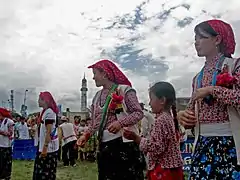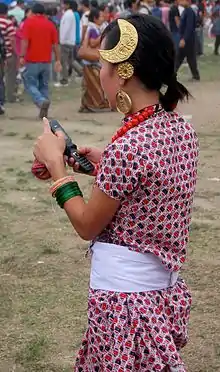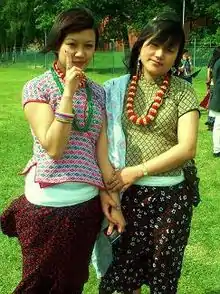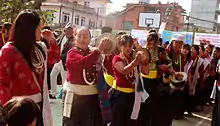Sakela
Sakela (साकेला) is the main festival of Khambu people (Rai) which is celebrated twice a year and is distinguished by two names Ubhauli and Udhauli. Sakela Ubhauli is celebrated during Baisakh Purnima (full moon day in the month of Baishak) and Sakela Udhauli is celebrated during the full moon day in the month of Mangsir.[1][2][3]
| Sakela (साकेला) | |
|---|---|
 | |
| Also called | Sakewa Sakhewa Sakenwa Sime Bhume Folsyandar Ubhauli Udhauli Tòsī Tòsh Chandi (mispronounced) |
| Observed by | Kirat Rais around the world |
| Type | Rai people, Kirat culture |
| Significance | Worship of nature and ancestors |
| Observances | Sakela sili, cultural group dance, religious services, family meetings, relative meetings |
| 2020 date | 7 May: Sakela Ubhauli 30 December: Sakela Udhauli |

Characteristics
The main characteristic of this festival is a ritual dance call Sakela dance performed by large groups of Kirats wearing their traditional attire. People from all ages dance together in a large circle. There are male and female leaders in each circle known as Silimangpa and Silimangma respectively. They choreograph the dance moves known as sili while others follow them. The sili reflects the different aspects of human life and their relationship with nature.[4] The ritual starts with chula puja, a worship of the chula at home by the Kirat Rai priest nakchhong. After the completion of the chula puja, nakchhong performs a sacrificial rite (usually with chicken) over a sacred place known as Sakela than, which is usually under a sacred tree.
The nakchhong signals the completion of the rituals by starting the Sakela dance himself/herself and the actual group Sakela dance commences. All dancers form a large circle and dance joyously around it. The beating of the Dhol and Jhyamta (traditional drums and cymbals) accompany the different silies guided by the Silimangpa and the Silimangma.
Among Kirats, Sunuwar and Rai celebrate this festival, whereas the Yakkhas and the Limbus have their own Youchyang and Chasok Tangnam. Despite important local variations, indigenists view these dances as specific as well as common to all Kirat.[2]
Significance

According to the Kirat holy book Mundhum, a year is divided into two phases: Ubhauli (going up) and Udhauli (going down). It is generally accepted that the naming comes from the migration pattern of birds. During the start of the winter season in Mangsir, the birds migrate downward toward the warmer terrain belt, and thus this phase of the year is known as Udhauli, meaning downward. Likewise, during the rise of the summer season, the birds migrate upward to the cooler hilly region, and therefore this phase is known as Ubhauli, meaning upward.
Kirats believe in shamanism and are worshippers of nature. The Sakela celebration is a prayer to mother nature for healthy crops and protection from natural calamities.[3] Therefore, the festival is also known as Bhumi Puja. Starting on Baisakh Purnima, Sakela Ubhauli is celebrated for 15 days in Baisakh (April/May) marking the beginning of the farming year. Similarly, the celebration of Sakela Udhauli during Mangsir (November/December), which is the harvest season, is the giving of thanks to mother nature for providing a good harvest.
Legend

The celebration of Sakela is connected to many myths. According to Kirat mythology, it is said that before the marriage of the Gods of the Kirats Sumnima and Paruhang, Paruhang used to live in the heaven. One day, he saw the beautiful Sumnima on earth and fell in love with her. He made a beautiful comb and sent it to her who then wished to wed him.

Four children were born after their marriage. But Paruhang left Sumnima in a hut on the bank of the Dudhkoshi river and did not return for a long time. One day, Sumnima saw a creeper growing on a rock while she was searching for food for her children. She tasted the creeper and found it was full of power and happiness. She brought the creeper and made a buti, an intoxicating religious garland, out of it. The buti inspired everybody who saw it to speak the truth about her/his life. One day Paruhang returned. He tried to counsel with the angry Sumnima. She then gave him the buti. This immediately made him happy and he started to tell her what he had done. He had spent the time looking at heaven and earth from the top of Chomolongma (Mount Everest). He also told her that he had meditated and visited the entire universe. Paruhang promised not to leave her again, which made Sumnima dance with joy. It is believed that her joyous dance is the Sakela dance. Tradition has it that young boys and girls come to participate in the Sakela dance in order to meet each other and find their love.
According to the Mundhum, the Rai people (Kirat) came out of the Khuwalung (sea or big river) meaning the Ganges river. Then followed the small river or the Saptakoshi. On their journey, they first met with a duck (hans), then a river bird (dhobi chara), a black bird (kalchuda), a deer (mirga), a thar, a musk deer (kasturi), etc. They journeyed through the Arun valley, Dudh Koshi valley, Sun Koshi valley, Tama Koshi valley and finally settled down in the Bhote Koshi valley. The Nakchhong, or the leader of the Sakela festival, narrates this Mundhum (history), where he tells the story of how their ancestors came out of the Khuwalung and met a duck and at the same time he dances in the pattern (sili) of a duck; likewise when he talks about the dhobi chara, he dances in the pattern of a dhobi chara. This is the Kirat way of relating the story (Mundhum) verbally and through acting.
Current trend
The Sakela dance has become very popular in the cities of Nepal, particularly among the younger generation. Kirat Rais celebrate this festival widely outside Nepal too, especially in Sikkim, Darjeeling district and Kalimpong district in India, Hong Kong, United Kingdom, Australia and United States. However, the real flavour of the dance can only be seen in the eastern hills of Nepal, the homeland of the Rai people. The increasing interest in Sakela has helped to spread this Nepali culture all over the world.
External links
| Wikimedia Commons has media related to Sakela. |
References
- Gaenszle, Martin (1997). "Changing concepts of ethnic identity among the Mewahang Rai". Nationalism and Ethnicity in a Hindu Kingdom. The politics of culture in contemporary Nepal: 351–373.
- Schlemmer, Grégoire (2004). "New past for the sake of a better future : re-inventing the history of the Kirant in East Nepal". European Bulletin of Himalayan Research. 25: 119–144.
- "Dancing to Ubhauli tunes". The Kathmandu Post. May 17, 2011. Retrieved 8 May 2012.
- Rai, Dik Bahadur (2012). The impacts of Modernization on the traditional Sakawa Sili festival in the Rai Kirat community of Nepal: a case study of the Rai community (Thesis). University of Tromsø.